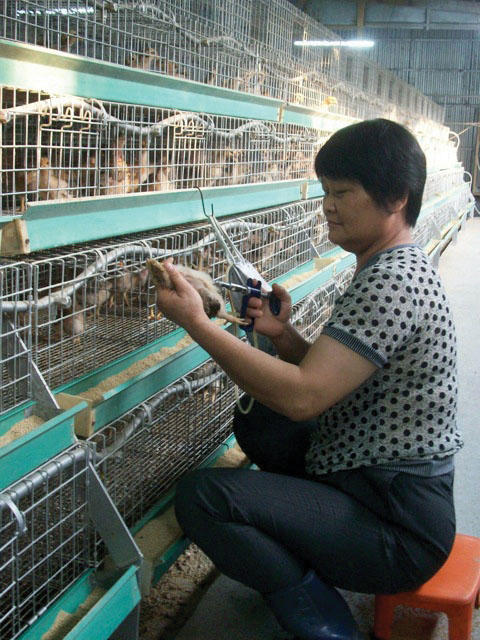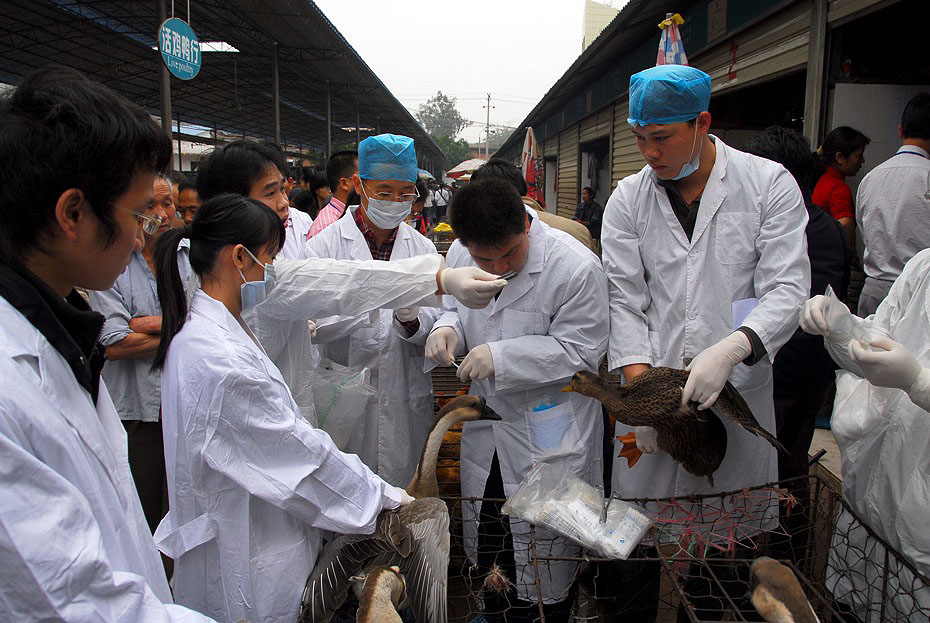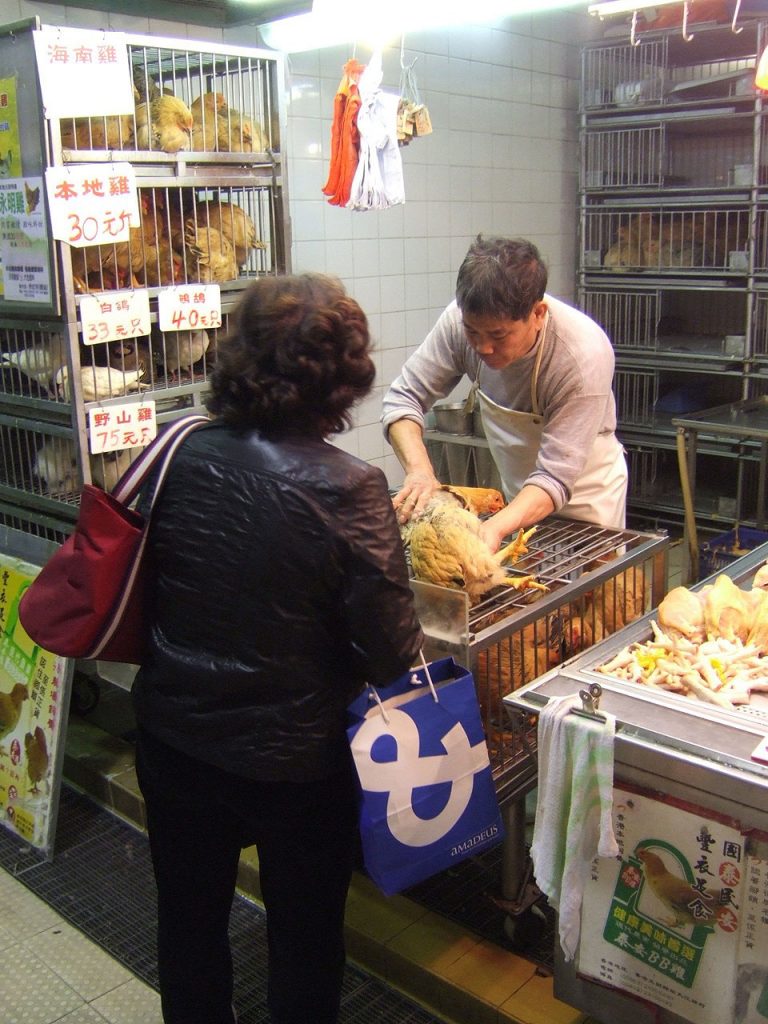In 2003, after helping to coordinate a tense but ultimately successful fight against SARS, a team of University of Hong Kong microbiologists published an article entitled, “The Next Influenza Pandemic: Lessons from Hong Kong.” It concluded with these words: “The studies on the ecology of influenza led in Hong Kong in the 1970s, in which Hong Kong acted as a sentinel post for influenza, indicated that it was possible, for the first time, to do preparedness for flu on the avian level” (Shortridge, Peiris, and Guan 2003). More than thirty five years earlier, the senior author of this paper, Kennedy Shortridge, had formulated what came to be known as the “influenza epicenter” hypothesis: Ducks and pigs living in proximity to humans in rice farming areas in South China create a perfect environment for the mutations and reassortment of flu viruses. Because SARS had caused both public health and governance crises in Hong Kong, in the following years the city made a major investment in research on emerging infectious diseases. Ken Shortridge’s prophecy, formulated decades earlier in response to the 1968 flu epidemic in the region, was finally taken seriously. This essay will reflect on what it means to name a city as a sentinel post, and in particular, on the relation between humans and animals in this setting.
The first major focus of Hong Kong’s expanded surveillance was the h5n1 virus, a strain of avian influenza that killed eight humans and 5000 birds in 1997. Lethal in humans, this virus appeared to be a candidate for the next great pandemic, though ultimately the difficulty of transmission between humans limited its scope (Peiris, de Jong, and Guan 2007). The 1997 outbreak showed that “preparedness” – a range of activities including stockpiling vaccines and designing simulations of a human-to-human transmission (Lakoff 2006) – should be practiced “on the avian level.” Tracking the mutations and reassortments of the flu virus in birds allowed microbiologists to anticipate a new strain that could successfully pass between humans.
When the SARS virus arrived in Hong Kong at the beginning of 2003 after emerging on the mainland in nearby Guangzhou a couple of months earlier, the team of microbiologists led by Ken Shortridge initially believed that it was a reemergence of the h5n1 virus. The virus produced the same symptoms in humans, and appeared to have transmitted in the same way from animals. After two weeks were lost testing for h5n1, the research team applied to SARS the same techniques of description that allowed them to successfully respond to the 1997 virus. They identified SARS as a coronavirus, and traced its animal origins in civet cats – consumed in Chinese traditional medicine – and bats. Considering animals as sentinels of emerging infectious diseases led the researchers to search for not just one but a multiplicity of viruses. As in other parts of the world, virologists in Hong Kong often describe themselves as “virus hunters” to emphasize their attentiveness to the different pathways of viruses from animals to humans.
But there is a shift from using animals as sentinels to considering a whole territory as a sentinel post for the emergence of viruses. A sentinel post is not only a space where sentinels are posted to watch for signals of threats. By redrawing their territory through the pathways of viruses, Hong Kong microbiologists have trained a whole range of actors – experts, administrations, farmers, birdwatchers, and even Buddhist authorities – to express their relation to animals in the language of viruses (Keck 2010). How do all these actors fit together into a “sentinel post”? How do they configure or reconfigure relationships between humans and animals in the perspective of a coming pandemic? And how does the singularity of the territory of Hong Kong allow this transformation?
Hong Kong is the gateway where commodities produced in China are inspected and distributed to destinations around the world. Hong Kong’s ambivalent relationship to its powerful neighbor has been transmitted from colonial to post-colonial times. Hong Kong residents are at once dependent on China for their wealth and suspicious of the quality and safety of the products coming from the mainland. During the SARS outbreak, when China refused to declare its first cases to the WHO, Hong Kong took on the role of sentinel in alerting the rest of the world to this new disease. Being a border territory, like the envelope of a cell, Hong Kong has become particularly sensitive to a variety of dangers coming from China.
There is more in the notion of a “sentinel post” than simply the tracing of a gateway. Not only does the sentinel send signals of possible threats from the border, it can also be the victim of the danger it signals. The territory serves not only as a stage for actors but also as a choir for a tragedy. In 2003, Hong Kong residents, and particularly nurses, were among the first victims of SARS (Abraham 2007). In responding to the h5n1 virus threat, the Hong Kong government in 1997 decided to kill all the live poultry raised on the territory. This decision proved prescient as the reservoir for the h5n1 virus was successfully eradicated. In the context of major anxiety about the handover of the British colony to the People’s Republic of China, the 1997 killing – or “culling” as it was euphemistically called – appeared as ambiguous. It showed that the new Hong Kong government cared for its human population, but also that it could act powerfully on animals to guarantee social order. A Chinese saying goes: “Kill the cock to frighten the monkey.”
Since sentinels are often the first to die in the face of a new threat, can we say that they are sacrificed for the sake of those who remain? Such a statement would fail to take account of the passionate interest of those who are involved with sentinel animals, and their participation in the production of a sentinel post. Hong Kong’s existence as a sentinel post was not only an alliance between experts in microbiology who focused on tracking the invisible mutation of viruses and the government which made decisions and mobilized resources to avoid the pandemic. The transformation of the territory into this new role also involved a greater number of actors and sensors. First, on the frontline are poultry farmers and retailers. After the government issued a Voluntary Surrender Act – note the military vocabulary – to close poultry farms in Hong Kong, only thirty enterprises remain today in what used to be a vibrant sector of the local economy. These farms are protected by extensive “measures of biosecurity (shengwu anquan)” (Hinchliffe and Bingham 2008): ponds to clean boots and wheels, fences and nets to confine the birds, etc. All chickens are vaccinated, save for a hundred “sentinels” that are meant to die first when a new virus reaches the farm. The Chinese characters used to describe these chickens, “shaobingji,” literally translate as “chickens that whistle like soldiers.”
Live poultry cannot be bought on the farm. Instead, birds are moved through Cheung Sha Wan Central Market, where approximately ten thousands chickens arrive every day from both Hong Kong and mainland China. These live birds are sent to local retail markets, where consumers can have them killed by the merchant. It is now forbidden to bring live poultry back to one’s home, as is still widely practiced on the mainland. Ironically, inspecting chicken’s cloaca to see if it is fresh and healthy – a traditional act of hygienic interpretation – is now considered a risky behavior only conducted by trained microbiologists collecting samples. Every week, samples from live poultry markets are sent to the lab of Hong Kong University to undergo testing for mutations of the Avian Flu virus.
This technique of sampling to determine whether a novel virus is emerging is also applied to wild birds. Hong Kong is a major location for migratory birds on the East Australasian flyway, and more than 500 species have been observed on the territory. Shrimp ponds (gei wai) on the Pearl River Delta around the village of Mai Po have been transformed by the World Wildlife Fund into a biodiversity reserve. The government has sub-contracted the monitoring of birds in this reserve to the Hong Kong Birdwatching Society, an association created in 1953, and relies on Hong Kong University students to collect bird feces and check the flu viruses. Monitoring biodiversity in Mai Po provides important indicators of environmental changes in the territory.
As a result of the Avian Flu outbreak, amateur scientists working in Mai Po came into a curious interaction with religious practitioners. The Hong Kong government had decided to close Mai Po reserve for three weeks every time a bird within a three kilometers perimeter of the reserve was found with h5n1. If infected birds were to be found in the urban area of Shenzhen or in the remaining poultry farms in Yuen Long, Mai Po would be shut to birdwatchers, even if no birds were infected in the reserve. To denounce what they saw as a policy lacking scientific grounding, birdwatchers joined up with Hong Kong University microbiologists to hold a press conference. They showed maps where known occurrences of h5n1 in Hong Kong converged around the most populous area of the New Territories: Mong Kok Bird Market. This is a major place for trade in wild birds, and a site for the Buddhist practice of “animal release” (fangsheng). Small birds, sometimes carrying h5n1, are brought to the market in stressful conditions and released in adjacent parks. After discussions with birdwatchers, microbiologists and government administrators, the Buddhist association banned this practice in Hong Kong, and advised worshippers to release seafood rather than birds. Posters on Buddhist temples show recently freed birds turning into skeletons as they leave the island – a Buddhist-inflected depiction of birds as sentinels.
This forum on bird release serves as one example of how Hong Kong as a sentinel post has become a stage for various types of performances. Clearly all actors don’t perceive the birds in the same way: Farmers see them as commodities in a food chain, birdwatchers as species in an ecosystem, Buddhists as souls in a cycle of reincarnations. But they have learned to express their various perceptions in a common language, that of microbiology. If an Avian Flu outbreak produces tensions in local residents’ ordinary perception of birds, shifting winged animals that once appeared as beneficial to eat or to watch into dangerous beings, the building of a sentinel post transforms this tension into a productive interaction. Because birds are mobile and diverse, they can sound alarms on future threats affecting humans: Trapped in the sentinel post, blurring the distinction between wild and domestic, they constitute a new kind of collective being, where relations between humans and animals are reconfigured in the language of viruses. The sentinel post is not a lonely soldier waiting for an invisible enemy: It is a choir of personae expressing the tensions of life on a border – between species and between countries.


